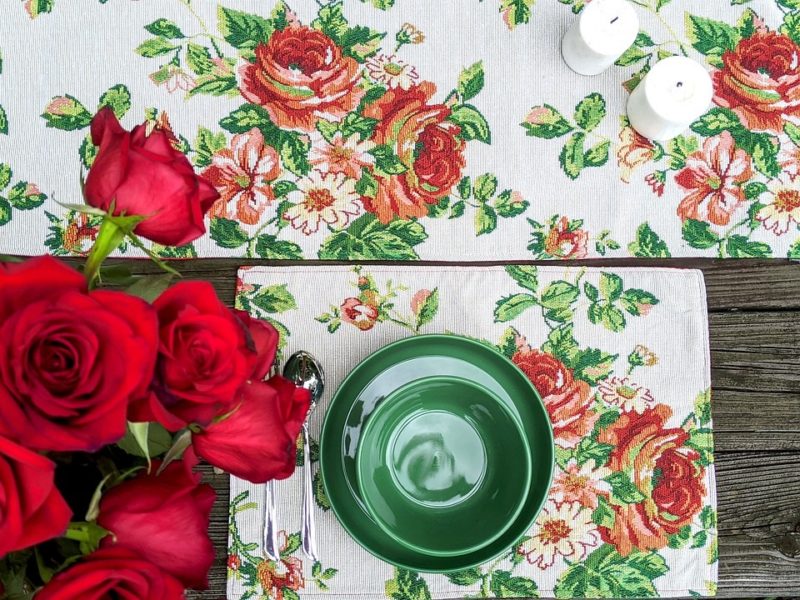You can easily learn how to make table runners for wedding in two easy steps. This DIY table runner tutorial is perfect for rustic weddings as you only need Rit dye and cheesecloth.
It’s also quick to make in case you don’t have time to make a table runner for the reception. And if you’re using rectangular tables, you can read how to set up long tables for the wedding reception.

How To Make Table Runners For Wedding Reception
Step 1. Measure your wedding table runner materials
- You can prepare any fabric you like as long as the material is suitable for tablecloths; for this DIY table runner, it’s best to use cheesecloth as they suit the rustic theme and most outdoor weddings with long tables
- Create a table runner with the size that’s appropriate for your wedding reception tables; for example, if your reception tables are 8 feet long, then you’ll need 10-foot long table runners for some allowance to hang on the table edge
- Use a fabric rotary cutter and mat to resize the cheesecloth for your convenience and cut accordingly
- If your wedding tables are not the same size, then adjust the table runner lengths accordingly
- Note that even circular wedding tables will have the same position of the long table runner in the middle as in rectangular wedding tables
Step 2. Dye the table runners
- For these table runners, you will dye the cheesecloth you cut earlier to make them more suitable for your wedding venue theme
- You can make different color wedding table runners or use a different color only on the wedding table runner of the head table; alternatively, you can make the tables of special friends and family more noticeable by having a different-colored DIY wedding table runner for them
- Rit dye should work for most fabrics; a useful tip is to test the dye on a scrap table runner material first, so you can adjust the formula and achieve the color intensity you want
- Prepare the bucket where you’ll dye the table runners and mix the dyeing solution accordingly
- Soak and move the table runner around the dyeing solution and rinse it until the water runs clear
- After dyeing, allow the dyed rustic table runners to dry completely
- You can also combine colors and experiment with the timings if you want an ombre effect
How Long Should A Wedding Table Runner Be?
When making wedding table runners, one of the first questions is how long they should be. Are they the same length as the tables or the tablecloth?
Usually, two feet of allowance is enough, but some suggest that you can provide six inches of extra runner material at either end of the table. Another helpful tip is it shouldn’t be longer than the table cloth.
You don’t want the guests to feel uncomfortable with excessive fabric on the sides, but the table runner should not be too short and look like an oversized mat. And as for the wedding table runner’s width, it should be one-third of how wide the table is for a formal look.
Will you use circular tables instead of rectangular ones at the wedding reception? Read how to decorate round tables for a wedding for tips you can use.
What Fabric Is Used For Wedding Table Runners?
When making a wedding table runner, you can select from different fabrics used as table linens. Compare the following materials to know what to use when creating wedding table runners:
Organza
Organza is one of the top choices for wedding table runners because you can even find embroidered types for added appeal in the table setting. It’s also see-through, so you can still showcase the table cloth underneath.
Cotton
Cotton makes an ideal wedding table runner because it’s cheap, especially for DIY projects. It’s also versatile enough that you can dye it quickly, and they can even be washed after so that you can reuse the runners on other occasions.
Satin
If you want a more luxurious DIY wedding table runner, use satin instead. The glossy look will instantly elevate your wedding tables, but note that satin is relatively high-maintenance than other materials.
Polyester
Those who want a cost-effective material for DIY wedding table runners can consider polyester. They are also versatile without you having to worry about them getting damaged with washes.
Table Runners Vs Table Cloths vs Table Skirts
Table runners are the linens you place over the table cloth. They are long and narrow and placed in the center of the table to make the decorations pop out.
Table cloths, on the other hand, are what cover the table themselves. They are the fabric backdrops, so they don’t need to be vibrant or heavily detailed like the table runner.
What about table skirts? Table skirts are added around the table’s sides for aesthetics and to hide the items underneath the table for functionality and style.
Conclusion
And that’s it! You just learned how to make table runners for wedding in two steps.
This tutorial uses cheesecloth that you’ll cut and dye to suit the table size and wedding theme. You can also experiment with other common wedding table runner fabrics like cotton or satin.
